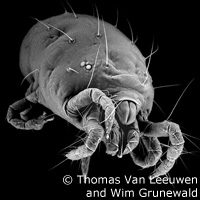Scientists sequence spider mite genome
An international research team has identified the first genome of the spider mite, which is part of the chelicerates - what experts say is one the largest groups of animals on our planet. Published in the journal Nature, the study discovered the genetic basis of the capacity of the spider mite to survive by feeding on more than 1 000 plants. This research, funded in part by a Marie Curie Incoming International Fellowship grant under the EU's Seventh Framework Programme (FP7), sheds new light on the evolution of arthropod and plant-herbivore interactions. This could lead to the development of new plant protection strategies. Despite its diminutive size, the spider mite (Tetranychus urticae) is an agricultural pest with the strong ability to fight off pesticides. Researchers led by the University of Western Ontario (UWO) in Canada completely sequenced and annotated the spider mite genome. This is the first complete chelicerate genome. T. urticae has the smallest sequenced arthropod genome, say the researchers, at 90 megabases. When comparing the spider mite genome to other arthropods, the team identified how this particular genome differs in the hormonal environment and organisation of the Hox complex. Hox genes contribute significantly to ensuring the proper basic structure and orientation of an organism. The results also highlight the evolutionary innovation of the production of silk. 'We find strong signatures of polyphagy and detoxification in gene families associated with feeding on different hosts and in new gene families acquired by lateral gene transfer,' the researchers write in the paper. Performing a deep transcriptome analysis of mites feeding on various plants reveals how this pest adapts to a changing host environment. It can multiply and evolve new genes for the detoxification of plant toxic molecules, effectively 'hijacking' the detoxification genes from bacteria, fungi and plants to fight the plants by incorporating them into its own genome. The various plants it feeds on include tomatoes, peppers, cucumbers, strawberries, apples, pears, maize and soya. Its consumption of these plants results in damages that top the EUR 735 000 mark. Despite its 'negative' characteristic, the spider mite has a positive feature as well: its ability to produce silk. This is a natural nanomaterial of extreme lightness that can be used to reinforce composite materials, such as those used in the auto and aeronautic industries, as well as in nanodevices and nanoprobes for evaluating the function of the cell. It can also be used as a matrix for tissue engineering and drug delivery. Thanks to this research, scientists can work on developing non-pesticide tools to make agriculture more sustainable. Such non-pesticide tools would help boost pest control and enable the production of pesticide-free food. Other funding for this project came from the government of Canada through Genome Canada, the Ontario Genomics Research Institute, and the Ontario Research Fund - Global Leadership Round in Genomics and Life Sciences. The researchers that contributed to this study were from Belgium, Canada, Chile, France, Germany, Japan, Portugal, Spain and the United States.For more information, please visit: Nature: http://www.nature.com/ University of Western Ontario: http://www.uwo.ca/ Marie Curie Actions: http://cordis.europa.eu/fp7/mariecurieactions/
Countries
Canada, Chile, Germany, Spain, France, Japan, Portugal, United States

